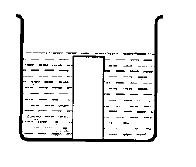In a mercury-glass thermometer the cross-section of the capillary portion is and the volume of the bulb is at . If and are the coefficients of linear and cubical expansion coefficients of glass and mercury respectively then length of mercury in the capillary at temperature is (Ignore the increase in cross-sectional area of capillary)
_E01_142_Q01.png)
The correct Answer is:A
Topper's Solved these Questions
- BOOK - ALLENCHAPTER - GEOMETRICAL OPTICSEXERCISE - EXERCISE -0311videos
GEOMETRICAL OPTICS
- BOOK - ALLENCHAPTER - GEOMETRICAL OPTICSEXERCISE - ASSERTION-REASON40videos
GEOMETRICAL OPTICS
- BOOK - ALLENCHAPTER - GEOMETRICAL OPTICSEXERCISE - EXERCISE -0165videos
GEOMETRICAL OPTICS
- BOOK - ALLENCHAPTER - CURRENT ELECTRICITYEXERCISE - All Questions427videos
CURRENT ELECTRICITY
- BOOK - ALLENCHAPTER - GRAVITATIONEXERCISE - EXERCISE 49videos
GRAVITATION
Similar Questions
In a mercury in glass thermometer the cross section of the capillary is A0 and volume of the bulb is V0 at 0∘C. If mercury just fills the bulb at 0∘C, find the that the length of mercury in the capillary at temperature t.∘C. Given that β=coefficient of cubical, expansion on mercury and α= coefficient of linear expansion of glass.
View SolutionVolume of the bulb of a mercury thermometer at 0∘C is V∘ and area of cross section of the capillary tube is A0, coefficient of linear expansion of glass is αg, and the cubical expansion of mercury is γm. If the mercury fills the bulb at 0∘C, find the length of mercury column in thermometer at T∘C
View Solution
Knowledge Check
- Question 1 - Select One
A glass container of volume V contains some mercury. The coefficients of cubical expansion for glass and mercury are γg and γm , respectively. If the volume of air inside the flask remains constant at different temperature, then the volume of mercury in the flask is
AγmVγgBγgVγmC(1−γmγg)VD(1−γgγm)V - Question 2 - Select One
A glass bulb contains air and mercury. What fraction of the bulb must be occupied by mercury if the volume of air in the bulb is to remain constant at all temperatures? The coefficient of linear expansion of glass is 9×10−6/K.
A320B32C520D12 - Question 3 - Select One
The diameter of a metal ring is D and the coefficient of linear expansion is α. If the temperature of the ring is increased by 10C, the circumference and the area of the ring will increases by
AπDα,2πDαB2πDα,πD2αCπDα,πDα2DπDα,πD2α2
a glass tube of length 133cm and of uniform cross-section is to be filled with mercury so that the volume of the unoccupied by mercury remains the same at all temperatures. If cubical coefficient for glass and mercury are respectively 0.000026/∘C and 0.000182/∘C , calculate the length of mercury column.
View SolutionIn a cylidrical glass container a solid silica is placed vertically at its bottom and remaining space is filled with mercury upto the top level of the silica. The volume of silica remains unchanged with variation in temperature. The coefficient of cubical expansion of mercury is γ and coefficient of linear expansion of glass is α. If the top surface of silica and mercury level remain at the same level wiht the variation in temperature then the ratio of volume of silica tothe volume of mercury is equal:
 View Solution
View SolutionThe height of a mercury column measured with a brass scale, which is correct and equal to H0 at 0∘C, is H1 at t∘C? The coefficient of linear expansion of brass is α and the coefficient of linear expansion of brass is α and the corfficient of volume expansion of mercury is γ. Relate H0 and H1.
View SolutionA mercury in glass thermometer has a stem of internal diameter 0.06 cm and contains 43 g of mercury. The mercury thread expands by 10 cm when the temperature changes from 0∘C to 50∘C. Find the coefficient of cubical expansion of mercury. Relative density of mercury =13.6 and αglass=9×10−6/K.
View SolutionA glass bulb of volume 250cc is filled with mercury at 20∘C and the temperature is raised to 100∘C. If the coefficient of linear expansion of glass is 9×10−6/∘C). Coefficient of absolute expansion of mercury is 18×10−5/∘C). The volume of mercury overflows
View Solution

